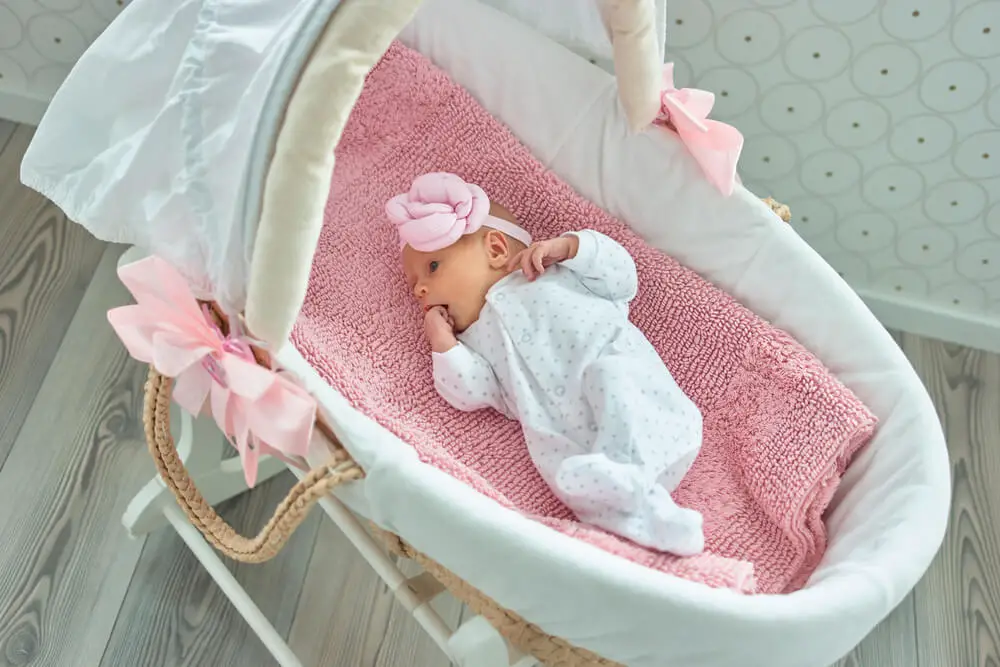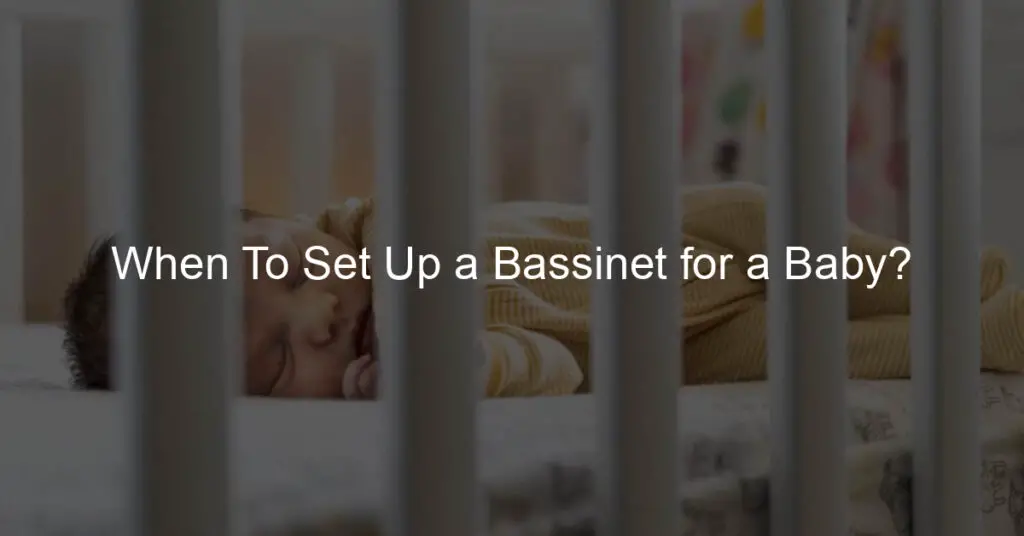Introduction to Setting Up a Baby Bassinet
Bringing a new baby into the world is an exciting time for parents. Among the many preparations, setting up a baby bassinet is one of the most important. This article will guide you through the process, ensuring your little one has a safe and comfortable place to sleep.
Understanding the Importance of a Baby Bassinet
A baby bassinet is more than just a piece of furniture. It’s a safe and cozy space where your newborn will spend a significant amount of their time. According to the American Academy of Pediatrics, using a bassinet can reduce the risk of Sudden Infant Death Syndrome (SIDS) by keeping the baby on their back while sleeping. It also allows you to keep your baby close, making nighttime feedings and diaper changes easier.
Key Factors to Consider When Setting Up a Baby Bassinet
When setting up a baby bassinet, safety should be your top priority. Ensure the bassinet is sturdy and has a firm, tight-fitting mattress. The bassinet should be placed in a safe location, away from windows, heaters, and cords. Additionally, it should be free of loose bedding, toys, and pillows to prevent suffocation. Lastly, consider the height of the bassinet. It should be at a level that allows you to easily see and reach your baby.
Setting up a baby bassinet may seem daunting, but with careful consideration and preparation, you can create a safe and comfortable environment for your newborn. In the following sections, we will delve deeper into the best time to set up a bassinet, how to prepare for it, and a step-by-step guide on how to do it.
Best Time to Set Up a Bassinet
Preparing for a newborn is an exciting time, filled with anticipation and joy. One of the key steps in this preparation is setting up the baby’s bassinet. But when is the best time to do this? Let’s explore this topic in detail.
Why timing is crucial in setting up a baby bassinet
Timing is a crucial factor when it comes to setting up a baby’s bassinet. It’s not just about having the bassinet ready for when the baby arrives, but also about ensuring that the environment is safe and comfortable for the newborn. Setting up the bassinet too early can lead to dust accumulation, which can potentially cause allergies or respiratory issues for the baby. On the other hand, waiting until the last minute can add unnecessary stress and rush, which is not ideal during the already hectic time of welcoming a new baby.
Factors influencing the best time to set up a bassinet
Several factors can influence the best time to set up a bassinet. These include:
Availability of time: The process of setting up a bassinet requires time and attention. It’s best done when you have sufficient time to assemble it carefully and check all the safety features.
Health of the mother: If the mother is experiencing a difficult pregnancy or has been advised bed rest, it might be best to set up the bassinet earlier to avoid any last-minute rush.
Space and cleanliness: The bassinet should be set up in a clean, clutter-free space. If you’re still organizing the baby’s room or your home, you might want to wait until everything is in place.
Delivery date: While it’s impossible to predict the exact delivery date, having a rough idea can help in planning when to set up the bassinet. A good rule of thumb is to have it ready about 2-3 weeks before the expected delivery date.
In conclusion, the best time to set up a bassinet depends on individual circumstances and preferences. It’s about finding a balance between being prepared for the baby’s arrival and ensuring a clean, safe, and comfortable environment for the newborn.

Baby Bassinet Preparation
Preparing for the arrival of your newborn is an exciting time. It’s also a time to ensure that your home is ready and safe for the baby. This includes setting up the baby’s room with a bassinet and other essential items.
Preparing for Baby Arrival
Here are some steps to help you prepare your home for your newborn:
Step-by-step guide to preparing your home for a newborn:
First, you need to baby-proof your home. This includes securing furniture to the wall, covering electrical outlets, and removing any small objects that the baby could choke on. Next, you need to set up the baby’s room. This includes setting up the bassinet, changing table, and other furniture. You also need to stock up on baby essentials like diapers, wipes, and baby clothes. Finally, you need to prepare yourself mentally and physically for the arrival of the baby. This includes attending prenatal classes, reading parenting books, and taking care of your health.
Essential items for a newborn’s room:
The newborn’s room should be a safe and comfortable space. Essential items include a bassinet or crib, a changing table, a rocking chair for feeding and soothing the baby, a diaper pail, a baby monitor, and a night light. You also need to stock up on baby essentials like diapers, wipes, baby clothes, and blankets. Remember, it’s not about having the most expensive items, but about choosing items that are safe and comfortable for the baby.
Preparing for the arrival of your newborn can feel overwhelming, but with a little planning and preparation, you can create a safe and comfortable environment for your baby.
Newborn Bassinet Setup
Setting up a newborn bassinet is a crucial step in preparing for your baby’s arrival. It involves choosing the right location, assembling the bassinet, and performing safety checks before use. Let’s dive into each step to ensure your baby’s comfort and safety.
Choosing the Right Location for the Bassinet
The location of the bassinet in your home is important. It should be in a quiet, well-ventilated area away from direct sunlight and drafts. The bassinet should be placed on a flat, stable surface and should not be near any cords or drapes that a baby could potentially pull on. It’s also recommended to keep the bassinet in the same room where you sleep for the first few months, as suggested by the American Academy of Pediatrics.
Assembling the Bassinet
Once you’ve chosen the perfect location, it’s time to assemble the bassinet. Follow the manufacturer’s instructions carefully to ensure that all parts are securely fastened. If you encounter any difficulties or missing parts, contact the manufacturer immediately. It’s important to remember that not all bassinets are the same, so the assembly process may vary.
Safety Checks to Perform Before Use
After assembling the bassinet, you must perform several safety checks. Make sure the bassinet is sturdy and doesn’t wobble. Check for any sharp edges or small parts that could pose a choking hazard. The mattress should fit snugly within the bassinet with no gaps. Regularly inspect the bassinet for wear and tear, and never use a damaged bassinet. Safety should always be your top priority.
Remember, setting up your newborn’s bassinet is not just about assembling a piece of furniture. It’s about creating a safe, comfortable space for your baby to rest and grow. By following these steps, you’re well on your way to providing the best for your little one.
Baby Bassinet Setup Guide
Setting up a baby bassinet can be a daunting task, especially for first-time parents. However, with the right guidance, it can be a smooth and enjoyable process. In this guide, we will provide you with practical tips on how to set up and maintain your baby’s bassinet.
Bassinet Setup Tips
Here are some essential tips to keep in mind while setting up your baby’s bassinet:
How to ensure the bassinet is safe and secure: Safety is paramount when it comes to setting up your baby’s bassinet. Make sure the bassinet is sturdy and does not wobble. Check all the screws and bolts to ensure they are tightly secured. The mattress should fit snugly within the bassinet without any gaps. Avoid placing any loose items like toys or blankets in the bassinet as they can pose a suffocation risk. For more information on bassinet safety, you can refer to the Wikipedia page on Bassinet Safety.
Tips for maintaining the bassinet: Regular maintenance of the bassinet is crucial to ensure its longevity and your baby’s comfort. Clean the bassinet regularly with mild soap and warm water. Avoid using harsh chemicals as they can irritate your baby’s skin. Check the bassinet for any wear and tear regularly and replace any broken parts immediately. If the bassinet comes with a removable and washable cover, make sure to wash it at least once a week.
Remember, the key to a successful bassinet setup is patience and attention to detail. Take your time and don’t rush the process. Your baby’s safety and comfort are worth the extra effort.
When to Prepare Baby Bassinet
Knowing when to prepare your baby’s bassinet is crucial. There are two main options: preparing the bassinet in advance or setting it up at the last minute. Both have their pros and cons, and the choice depends on your personal circumstances and preferences.
Preparing the Bassinet in Advance
Setting up the bassinet well before the baby’s arrival can be a good idea. It gives you plenty of time to ensure everything is in order and to make any necessary adjustments. This way, you can be sure that the bassinet is safe, secure, and comfortable for your baby.
According to a Wikipedia article, a bassinet should be prepared at least a month before the baby’s due date. This allows you to gradually prepare the nursery, reducing stress and last-minute rush.
Last-Minute Bassinet Setup
On the other hand, some parents prefer to set up the bassinet closer to the baby’s arrival. This can be due to space constraints, superstitions, or simply personal preference. If you choose this option, make sure you have all the necessary items and know how to assemble the bassinet correctly. This way, you can set it up quickly when needed.
Remember, the most important thing is that the bassinet is ready and safe when your baby arrives. Whether you choose to prepare it in advance or at the last minute, make sure you follow the manufacturer’s instructions and safety guidelines.
Baby Nursery Preparation
Preparing a baby nursery is an exciting task for expectant parents. It is crucial to create a comfortable and safe environment for your little one. Let’s explore how to achieve this.
Creating a Comfortable Environment
Comfort is key when setting up a baby nursery. This involves choosing the right temperature and lighting, as well as selecting safe and comfortable bedding. Let’s delve into these aspects.
Choosing the right temperature and lighting
Keeping the nursery at an optimal temperature is vital for your baby’s comfort. The American Academy of Pediatrics recommends a room temperature of 68–72°F (20–22.2°C) for a baby’s room. This helps to reduce the risk of Sudden Infant Death Syndrome (SIDS) and ensures your baby is neither too hot nor too cold.
Lighting also plays a significant role in creating a comfortable environment. During the day, natural light is best. However, for nighttime, consider using a dimmer or a nightlight. This will provide enough light for you to see, but won’t disturb your baby’s sleep.
Selecting safe and comfortable bedding
When it comes to bedding, safety should be your top priority. The American Academy of Pediatrics advises against using loose bedding, soft objects, or crib bumpers in a baby’s sleep area. These items can increase the risk of SIDS. Instead, opt for a firm mattress with a fitted sheet.
Comfort is also crucial. Choose soft, breathable fabrics like cotton for your baby’s sheets. This will help regulate your baby’s body temperature and ensure they have a comfortable sleep.
In conclusion, creating a comfortable environment for your baby involves careful consideration of temperature, lighting, and bedding. By following these guidelines, you can ensure your nursery is a safe and cozy space for your little one.
Organizing Baby Essentials
When preparing for a new baby, organizing baby essentials is a crucial task. It not only makes your life easier but also ensures that your baby’s needs are promptly met. Let’s dive into how you can efficiently organize baby clothes, diapers, and other essentials, and keep the nursery clean and hygienic.
How to efficiently organize baby clothes, diapers, and other essentials
Organizing baby essentials can seem overwhelming, but with a few smart strategies, you can create an orderly system that works for you and your baby. Here are some tips:
Sort baby clothes by size and season. Use storage bins or drawers labeled with size ranges.
Keep diapers, wipes, and other frequently used items within easy reach of the changing table.
Use a diaper caddy to store and transport diapers and wipes from room to room.
Organize baby toys and books on low shelves or in baskets so they’re easily accessible.
Remember, the goal is to create a system that makes it easy to find what you need when you need it.
Keeping the nursery clean and hygienic
Keeping the nursery clean and hygienic is essential for your baby’s health and safety. Here are some tips:
Clean and sanitize the changing table regularly.
Wash baby clothes, bedding, and toys often to remove dirt and germs.
Keep a trash bin with a lid in the nursery for dirty diapers.
Regularly air out the nursery to keep it fresh and free from odors.
By following these tips, you can ensure that your baby’s nursery is a clean, safe, and organized space.
Bassinet Setup for Newborns
Setting up a bassinet for your newborn is an exciting task. It’s a key step in preparing for the arrival of your little one. To help you understand the process better, let’s take a look at two case studies.
Case Studies
Case Study 1: Successful Bassinet Setup
Meet Sarah, a first-time mom who had a successful bassinet setup experience. She started the setup process about two months before her due date. This gave her ample time to research, purchase, and assemble the bassinet. She also had time to make any necessary adjustments to ensure the bassinet was safe and comfortable for her baby.
Key to her success was her meticulous approach. She followed the manufacturer’s instructions to the letter, ensuring that all parts were correctly installed and secure. Sarah also made sure the bassinet was placed in a safe location, away from windows, heaters, and cords. Her baby has been sleeping soundly in the bassinet since day one.
Case Study 2: Lessons Learned from a Poorly Timed Bassinet Setup
Then there’s John, a dad who learned the hard way about the importance of timing in bassinet setup. He waited until a week before the due date to start setting up the bassinet. Unfortunately, his baby arrived earlier than expected, and the bassinet was not ready.
John had to scramble to get the bassinet set up while also caring for his newborn. He made a few mistakes in his haste, like not securing all the parts properly. This led to some sleepless nights as he had to readjust and secure the bassinet multiple times. John’s experience shows the importance of setting up the bassinet well in advance of the baby’s arrival.
These case studies highlight the importance of proper planning and timely setup of your baby’s bassinet. Remember, the safety and comfort of your newborn should be your top priority.
Key Takeaways
Importance of Timing in Setting Up a Baby Bassinet
Timing is crucial when setting up a baby bassinet. It’s best to have the bassinet ready at least a few weeks before the baby’s due date. This allows ample time for any necessary adjustments and ensures that the baby has a safe and comfortable place to sleep from day one. A bassinet that is set up too late can cause unnecessary stress and may not provide the optimal environment for your newborn.
Essential Steps in Newborn Bassinet Setup
Setting up a bassinet for a newborn involves several key steps. First, choose a safe and sturdy bassinet. Next, assemble it according to the manufacturer’s instructions, ensuring all parts are secure. Then, add a firm mattress and a fitted sheet designed for the specific model of your bassinet. Avoid adding pillows, blankets, or stuffed animals, as they can pose a suffocation risk for newborns. Finally, place the bassinet in a suitable location in your home, ideally close to your bed for easy nighttime feedings and check-ins.
Tips for Successful Baby Nursery Preparation
Preparing a baby nursery involves more than just setting up a bassinet. It’s also important to consider the room’s temperature, lighting, and noise levels. Keep the room at a comfortable temperature, ideally between 68-72°F (20-22°C). Use curtains or blinds to control the amount of light in the room, and consider using a white noise machine to help soothe your baby to sleep. Also, remember to organize baby essentials like diapers, clothes, and feeding supplies for easy access. A well-prepared nursery can make a big difference in your baby’s comfort and your convenience.















